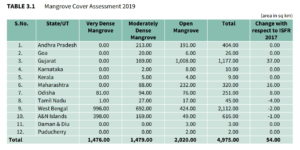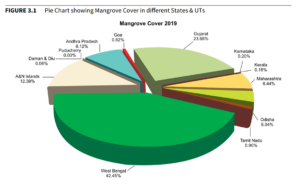Mangrove Cover is on the Rise in India
India’s biennial State of Forest Report is out – and mangrove cover has increased overall.
A summary of the 2021 State of Forest Report is available here.
The Ministry of Environment, Forest & Climate Change Government of India released Volume 1 of the report at the end of 2019. Chapter 3 is dedicated to mangrove cover with statistics and details about what states are doing to advance mangrove conservation. Here are some of the overarching statistics about mangrove cover in the country:
“About 40% of [the] world’s mangrove cover is found in South East Asia and South Asia… India has about 3% of the total Mangrove cover in South Asia”
“Mangrove cover in the country has increased by 54 sq km (1.10%) as compared to the previous assessment.”
“The current assessment shows that mangrove cover in the country is 4,975 sq km [(1.2 million acres)], which is 0.15% of the country’s total geographical area.”

“…West Bengal has 42.45% of India’s mangrove cover, followed by Gujarat 23.66% and A&N Islands 12.39%. Gujarat shows maximum increase of 37 sq km in mangrove cover [(over 9,000 acres)].”

“…South 24 Parganas district of West Bengal alone accounts for 41.85% mangrove cover of the country.” South 24 Parganas holds the Sunderban National Park, home to one of the largest mangrove forests in the world.
A female Bengal tiger resting in the undergrowth of a mangrove forest in the Southeast Sundarbans, Khulna Province, Bangladesh. © naturepl.com / Tim Laman / WWF
“Varied topography and climate regimes, large geographical area, long coastline and oceanic islands have endowed India with a diversity of natural biomes from deserts to alpine meadows, tropical rain forests to temperate pine forests, mangroves to coral reefs and marshlands to high altitude lakes. The diversity of forests in India makes it resilient to climate change and also an efficient sink of carbon.”
The full report PDF is available here.